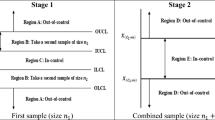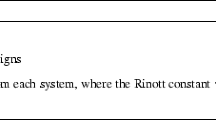Abstract
An efficient particle Markov chain Monte Carlo methodology is proposed for the rolling-window estimation of state space models. The particles are updated to approximate the long sequence of posterior distributions as we move the estimation window. To overcome the well-known weight degeneracy problem that causes the poor approximation, we introduce a practical double-block sampler with the conditional sequential Monte Carlo update where we choose one lineage from multiple candidates for the set of current state variables. Our proposed sampler is justified in the augmented space through theoretical discussions. In the illustrative examples, it is shown to be successful to accurately estimate the posterior distributions of the model parameters.









Similar content being viewed by others
Notes
In the discussion, the notation [k, l] (\(k<l\)) works as “an index” that indicates the interval from k to l.
The marginal density of \({\hat{\pi }}\) is \(\pi (x_{s-1:t-K-1}, x^{\dagger }_{t-K:t}, \theta \mid y_{s-1:t})\) as shown in Proposition 5.1 with \(x^{\dagger }_{t-K:t}=(x_{t-K}^{k_{t-K}^*},\ldots ,x_t^{k_t^*})\).
The marginal density of \({\check{\pi }}\) is \(\pi (x_{s:s+K-1}^{\dagger }, x_{s+K:t}, \theta \mid y_{s:t})\) as shown in Proposition 5.3 with \(x^{\dagger }_{s:s+K-1}=(x_{s}^{k_{s}^*},\ldots ,x_{s+K-1}^{k_{s+K-1}^*})\).
We use the notation \({\hat{p}}(y_t \mid x_{t-K-1}^n,y_{s-1:t-1},\theta ^n)\) since it is an unbiased estimator of \(p(y_t \mid x_{t-K-1}^n,y_{s-1:t-1},\theta ^n)\) as we shall show in Proposition 5.2.
Note that we need to generate \(x_{s-1}^{n,m}\) to compute \({\hat{p}}\) in (32).
The data are downloaded at http://realized.oxford-man.ox.ac.uk/data/download.
We also tried using other values of M but the computation time is the shortest with \(M= 300\).
Also see Supplementary Material C for the comparison of the computation time of the practical double-block sampler with those of the MCMC and the particle MCMC.
References
Andrieu, C., Doucet, A., & Holenstein, R. (2010). Particle Markov chain Monte Carlo methods. Journal of the Royal Statistical Society, Series B: Statistical Methodology, 72(3), 269–342.
Chopin, N., Jacob, P. E., & Papaspiliopoulos, O. (2013). SMC2: An efficient algorithm for sequential analysis of state space models. Journal of the Royal Statistical Society Series B: Statistical Methodology, 75(3), 397–426.
Chopin, N., & Singh, S. S. (2015). On particle Gibbs sampling. Bernoulli, 21(3), 1855–1883.
Del Moral, P., Doucet, A., & Jasra, A. (2006). Sequential Monte Carlo samplers. Journal of the Royal Statistical Society. Series B: Statistical Methodology, 68(3), 411–436.
Doornik, J. A. (2009). An object-oriented matrix programming language—Ox 6. London: Timberlake Consultants Press and Oxford. www.doornik.com.
Doucet, A., Briers, M., & Sénécal, S. (2006). Efficient block sampling strategies for sequential Monte Carlo methods. Journal of Computational and Graphical Statistics, 15(3), 693–711.
Fulop, A., & Li, J. (2013). Efficient learning via simulation: A marginalized resample-move approach. Journal of Econometrics, 176(2), 146–161.
Heber, G., Lunde, A., Shephard, N., & Sheppard, K. (2009). Oxford-man Institute’s realized library. version 0.2, Oxford-Man Institute, University of Oxford.
Lee, A., Singh, S. S., & Vihola, M. (2020). Coupled conditional backward sampling particle filter. Annals of Statistics, 48(5), 3066–3089.
Naesseth, C.A., Lindsten, F., & Schön, T.B. (2015). Nested sequential Monte Carlo methods. arXiv preprint arXiv:1502.02536.
Omori, Y., Chib, S., Shephard, N., & Nakajima, J. (2007). Stochastic volatility with leverage: Fast and efficient likelihood inference. Journal of Econometrics, 140(2), 425–449.
Polson, N. G., Stroud, J. R., & Müller, P. (2008). Practical filtering with sequential parameter learning. Journal of the Royal Statistical Society. Series B: Statistical Methodology, 70(2), 413–428.
Shephard, N., & Sheppard, K. (2010). Realising the future: Forecasting with high-frequency-based volatility (HEAVY) models. Journal of Applied Econometrics, 25(2), 197–231.
Takahashi, M., Omori, Y., & Watanabe, T. (2009). Estimating stochastic volatility models using daily returns and realized volatility simultaneously. Computational Statistics and Data Analysis, 53(6), 2404–2426.
Whiteley, N., Andrieu, C., & Doucet, A. (2010). Efficient Bayesian inference for switching state-space models using discrete particle Markov chain Monte Carlo methods. arXiv preprint arXiv:1011.2437.
Acknowledgements
We thank the Editor and two anonymous referees for their helpful comments. All computational results in this paper are generated using Ox metrics 7.0 (see Doornik (2009)). This work was supported by JSPS KAKENHI Grant numbers 25245035, 26245028, 17H00985, 15H01943, 19H00588.
Author information
Authors and Affiliations
Corresponding author
Additional information
Publisher's Note
Springer Nature remains neutral with regard to jurisdictional claims in published maps and institutional affiliations.
Supplementary Information
Below is the link to the electronic supplementary material.
Rights and permissions
About this article
Cite this article
Awaya, N., Omori, Y. Particle rolling MCMC with double-block sampling. Jpn J Stat Data Sci 6, 305–335 (2023). https://doi.org/10.1007/s42081-022-00170-2
Received:
Revised:
Accepted:
Published:
Issue Date:
DOI: https://doi.org/10.1007/s42081-022-00170-2




